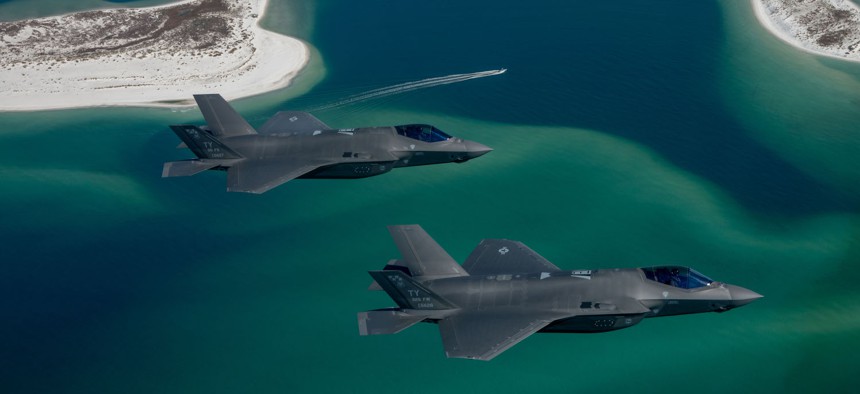
U.S. Air Force F-35A Lightning IIs assigned to the 95th Fighter Squadron, Tyndall Air Force Base, Florida, fly over the Gulf of Mexico, Nov. 7, 2023. U.S. Air Force / Tech. Sgt. Betty R. Chevalier
Pentagon to give Pratt & Whitney sole-source F-35 engine upgrade work
Company declares itself on track to deliver preliminary design for January review.
Expect the preliminary design for the F-35's engine upgrade within weeks and the finished product by 2029, Pratt & Whitney said as the Pentagon declared its intention to make the company the sole provider of fixes for the jets’ overheating engine.
The announcement, while expected, was nevertheless a blow to GE Aerospace, which had proposed to deal with the problem by replacing the Pratt-built F135 engine with a next-gen power plant.
The F-35 Joint Program Office will give Pratt “multiple follow-on contract actions on a sole source basis,” according to a Nov. 27 notice.
The contract for the next phase of development will be awarded in the second quarter of fiscal 2024 and fund Pratt’s effort through the end of 2031, JPO said. The amounts of the contracts were redacted from the documents.
“The anticipated contract actions will provide F135 [Engine Core Upgrade] design maturation, test article manufacturing and development, test asset procurement, validation and verification activities, weapon system integration for air system capabilities, test equipment procurements, and developmental hardware procurements for the F-35A, F-35B, and the F-35C variants,” JPO said.
Pratt will complete preliminary design work on the ECU next month, paving the way for official review in January, said Jen Latka, Pratt's vice president for the F135 program.
“Pratt & Whitney has 600 employees fully dedicated to this effort, and we’re on track to deliver F-35 operators the power needed to enable Block 4 capabilities and beyond starting in 2029,” Latka said in a statement.
The JPO document outlined “overarching” requirements for the engine upgrade, including maintaining a common engine between the three variants and improving overall engine life.
“Due to the nature of the F-35 program, it is critical the F135 ECU be common across the F-35A, F-35B, and F-35C variants, be partner releasable, and be available to Foreign Military Sales customers,” JPO said.
Engine commonality and cost were some of the main reasons why the Air Force Secretary Frank Kendall said in March that the service would pursue an engine upgrade instead of a new, adaptive engine for the F-35. An adaptive engine would improve thrust and fuel efficiency but would not fit in the Marine Corps’ F-35B variant, whose large lift fan enables the aircraft to take off from very short runways and land vertically.
Pratt and General Electric both have teams developing an adaptive engine under the Air Force’s Adaptive Engine Transition Program. This announcement is a blow to GE, which has been lobbying Congress to keep funding its adaptive engine for the F-35.
Pratt and GE plan to use the technology developed in AETP when they compete to build the engine that will power the Air Force’s next fighter jets under a program dubbed Next Generation Adaptive Propulsion, or NGAP.



